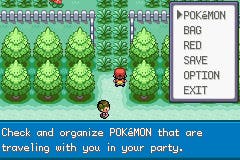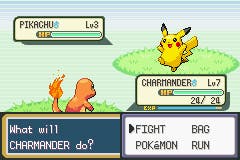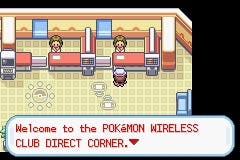Pok¨Śmon Leaf Green/Fire Red review
Does the 'Gotta catch 'em all' slogan extend to buying all the games as well?
Order yours now from Simply Games.
You reap what you sow. Yet when Nintendo released Pokémon Red back in 1997, even it couldn’t have guessed what would grow from the deceptively simple premise. A TV series? A staggering amount of cuddly merchandise? Highly possessive ten-year olds with the trading skills of a stock exchange veteran? It’s incredible really.
Or perhaps not. The truth, which many people are loath to admit, is that Pokémon is a masterclass in children’s entertainment. It is not merely a cleverly marketed product of wily old Nintendo - rather it is a genuinely compelling and well-executed series.
Despite this, however, you can’t help but feel that the double header that is Pokémon Leaf Green/Fire Red is where the franchise takes a discouraging turn for the worse. Not because of a sudden dip in standards, but because of a sudden dip in imagination.
Reissue, repackage, repackage

Unlike previous sequels in the series, Leaf Green/Fire Red is essentially a remake of the first Pokémon games, Red and Blue. So while newcomers will be pleased with how polished and huge the gameplay on offer is, veteran Poke-trainers might be a little miffed at having to tread an altogether familiar path.
For the uninitiated (if any exist - hands up who's never played a Pokémon game and tell us in less than 25 words why), the basic premise of a Pokémon game is to wander around, collect and train monster-pets to do battle in a simple RPG setting. At its heart, the gameplay is pretty straightforward in a Top Trumps kind of sense, with each Pokémon having strengths and weaknesses that must be used strategically in battle. For example, a water Pokémon will be strong against a fire Pokémon. However, each creature can also learn a selection of skills - many of which affect vital stats or inflict ailments - and it is through careful use of these that the more difficult battles will be won or lost.
In truth, though, the battle system itself isn’t what makes these games so much fun. Instead, the most satisfying element is best summed up by that most annoying of taglines: ‘Gotta catch ‘em all!’ Catching your Pokémon, and subsequently raising them, evolving them and turning them into high-level killing machines is insanely compelling.
Compelling or just obsessive?

The sense of ‘ownership’ you get from naming and rearing a Pokémon is satisfying in the same way that all good RPGs are: there’s a real sense of accomplishment and control, even if it is just an illusion, or the symptoms of the kind of obsessive compulsive disorder that many of us gamers go through at one time or other.
In that regard, this surpasses all other Pokémon games before it. It has a huge selection of creatures to capture - most of the Pokémon from the other GBA titles are in there - and it keeps on going where the original Red and Blue titles ended, offering high-level challenges to experienced players. It also features the ‘two-on-two’ battles that weren’t in the first games and is generally the most comprehensive game in the series yet.
But that still doesn’t negate the fact that Nintendo has failed to bring anything new to the table with Leaf Green/Fire Red. Surely we have gone through enough of these games to warrant a bit more effort in the innovation department? Even a visual overhaul would be nice at this point.
But hey, they threw in a Wireless adaptor...no....wait...

After all, one of the staples of the series is the ‘evolution’ of Pokémon - could the same philosophy not be applied, more liberally, to the gameplay? The one saving grace, in that regard, is the addition of a wireless adapter with both Leaf Green and Fire Red. This basically takes the place of a link cable (though it only works with a few games at present, including Mario Golf Advance Tour) and lets players battle each other and trade Pokémon within three feet, and instant chat messaging for them to call each other names. It’s a welcome bonus that’s sure to please the more rabid Pokémon fans and their equally rabid friends, but it’s not the extreme shake-up that we’d like to see.
You reap what you sow. If Nintendo hadn’t made Leaf Green/Fire Red such a comprehensive example of what has made Pokémon so successful, then we would have been far more critical. Instead, it has - just about - earned one last harvest from this series. Newcomers to Pokémon can justifiably add a point to the score below, because as a first-time experience it would be addictive, satisfying and value for money. Veteran trainers, on the other hand, need to ask themselves if they want more of the same… again. If not, then perhaps it’s time for Nintendo to move on to pastures new?
